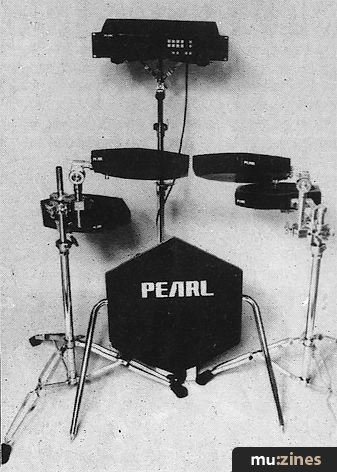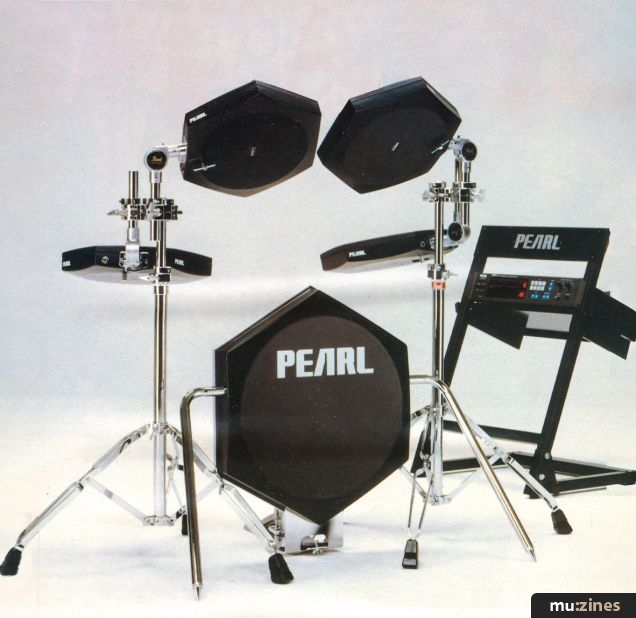Magazine Archive
Home -> Magazines -> Issues -> Articles in this issue -> View
Pearl DRX-1 Electronic Kit | |
DrumcheckArticle from International Musician & Recording World, May 1985 | |
Pearl make their first foray into electronic percussion. Bob Henrit was there

Ever had that déja vu feeling?
I'm sure it comes as no surprise that Pearl have come up with a professional electronic drum set at last. After all, they are arguably the major manufacturers of 'real' drums on a world wide basis, so why shouldn't they expand sideways as it were? Obviously they feel that there's a demand for yet another electric, solid-bodied set and are prepared to fill that gap. Of course this isn't Pearl's first synthesized rum-kit — they were also responsible for the 'Fight man' a couple of years ago, However, DRX-1 is all together a different and more professional proposition.
Pads
At first sight they look more 'chunky' than any of the competitions. They are, as you can see from the photo, hexagonal measuring roughly 12" from point to point and just over 1½ inches deep. The bowls themselves are formed from some sort of ABS-type plastic with a very playable circular piece of rubber set into the centre. This makes the remainder of the top of the pad stick up proud of the head. To tell you God's honest truth, I wasn't able to take them apart without ruining them. But on peering through the holder's receiver hole I couldn't see an evidence of wood. I presume them to be made in a high tech way with internal strengthening 'ribs' cast into the mould. It would, of course, be based on the 'lid and container' principle with the piezo (or whatever) transducer set under the head somewhere. There's a jack-socket set into the edge of the pad next to the 'key plate' which covers the hole for the tube from the tom arm. (This plate is shaped to accommodate one of Pearl's memory clips). Inside the pad itself is a very simple pressed steel clamp which grips the holder-pipe and can be locked securely by a 'T' screw set into the bottom of the unit.
The bass pad is a similar hexagonal shape too, measuring roughly 18" across and actually standing on one of its points. It's jacked up a further three inches by an 'L' shaped metal plate with a rubber pad stuck to it that accommodates the bass drum pedal. It also has a screw — adjustable, sprung spur-tapped into this plate. As per usual the bass pad is slightly thicker than the others and with a piece of ½" 'L' shaped right angled aluminium to keep its lid on. This 'Lid' is plastic too with (I suspect) a piece of word behind: in its centre there's a spongy rubber pad held in place with a metal ring. This, of course, is where the beater hits and presumably a transducer is placed directly behind it too. Large tabular spurs are fitted which locate into the same sort of receiver collars used for the tom arms. They're inside the main body of the pad. The only other attribute it has is a jack-socket set into the 'head' itself. The Pearl logo is stencilled in white onto all the pads. That, my friends, is more or less it for the pads.

Stores eight complete kit sounds
Brain
It seems to me that this brain embodies functions from most of the other manufacturers but with a few very nice touches. First of all 'ears' are fitted as standard to immediately make it rack-mountable. It also has a headphone socket where many others don't — this enables you to practise quietly or set up sounds in peace.
The brain is very simple to operate; once you get used to it. There are a series of eight square buttons to select different 'lifts' — simply press one to change the sound totally. Three pairs of buttons adjust the values of these sounds up and down. For example, degrees of pitch can be changed from 0-19, bend, oscillators/noise, overtone, attack, filter, decay and level. A higher number, of course, gives you more of any of these functions and the number shows up in a window as with most synthesizers. No doubt you'll recognise those control titles — all synth drums have them but invariably with rotary 'Pots' to adjust them. Pearl offer simply a more up to date method of control. In many ways it's more convenient since we're dealing with numbers in a window, not with arbitrary switch positions. If you can operate a modern TV then you'll be able to cope with DRX-1.
So, I've said we can adjust the value of the function up and down but we must select which parameter we're working on by using the parameter buttons also up and down. An LED shows up in a little square which is labelled pertaining to each. There are also a further two buttons which take us back or forward through snare, bass, or three toms. These serve to tell us which percussion instrument we're messing with. Again a red LED gives us the clue. Sensitivity is very important too and adjustable by five small-ish trimmers. This level also has its own window with four LEDS giving a value from one to four. For good dynamics it should run from one through to four. Finally there's a window which shows whether the memory protection is on or not. This will safeguard your newly-made programmes and a switch at the back operates it.
These programmes are child's play to set up and I'm pretty sure that Pearl will supply a few sample programmes to get you started. When you first buy the unit the first seven channels are loaded with programmes which can, of course, be overwritten. Channel eight is totally blank for you to experiment.
To back up the memory Pearl install lithium batteries which are said to last for at least five years.
Otherwise the front of the unit has the aforementioned headphone socket with rotary volume control. This allows you to plug a tape deck or record player into the DRX-1 brain and play along; a DIN plug at the back allows you to do this. There is no overall volume control on the unit.
The back of the brain has jack sockets for input from the five pads (or presumably from a drum machine), separate outputs for each pad, mix output and two DIN sockets. One is for line select via a footpedal like SDS8's and the other line in.
Conclusion
I have to say that I'm impressed by DRX-1. It's terribly simple and logical to work, easy to play — although perhaps the pads could be a little harder for my taste — and its sounds are very good. This is due to the fact that it uniquely has three oscillators. Obviously one needs time to get the optimum from the set but, as I invariably write, it's a learning process which you have to stick with, especially if you've made an investment. £1000 seems particularly cheap to me for DRX-1 and something of a bargain. I haven't mentioned the stands on purpose since they're the usual Pearl collection with double-braced legs and twin tom arms.
The set I saw was matt-black and looked very solid — I don't know if other colours are available but wouldn't be surprised.
My main criticism is that it's difficult to know which instrument or parameter you're working on in the dark because the boxes don't show up even though the LED does. However, set against this the fact that it's possible to put an effect on just one percussion instrument and still use the mix output.
Finally, I have it on reasonably good authority that many manufacturers who produce hexagonal pads are being asked to 'cease and desist' because they're infringing a trademark. If this is the case we may be seeing this and several other sets with new pads, certainly in America.
PEARL DRX-1 — RRP £1000 (approx)
Also featuring gear in this article
Captive-Eight - Pearl DRX-1 Electronic Drums
(ES May 85)
Pearl DRX-1
(12T Apr 85)
Pearl DRX1 Electronic Drums
(EMM Apr 85)
Browse category: Drums (Electronic) > Pearl
Publisher: International Musician & Recording World - Cover Publications Ltd, Northern & Shell Ltd.
The current copyright owner/s of this content may differ from the originally published copyright notice.
More details on copyright ownership...
Gear in this article:
Review by Bob Henrit
Previous article in this issue:
Next article in this issue:
Help Support The Things You Love
mu:zines is the result of thousands of hours of effort, and will require many thousands more going forward to reach our goals of getting all this content online.
If you value this resource, you can support this project - it really helps!
Donations for October 2025
Issues donated this month: 0
New issues that have been donated or scanned for us this month.
Funds donated this month: £0.00
All donations and support are gratefully appreciated - thank you.
Magazines Needed - Can You Help?
Do you have any of these magazine issues?
If so, and you can donate, lend or scan them to help complete our archive, please get in touch via the Contribute page - thanks!








